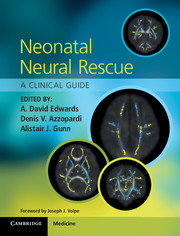Book contents
- Frontmatter
- Contents
- List of contributors
- Foreword
- Section 1 Scientific background
- Section 2 Clinical neural rescue
- 6 Challenges for parents and clinicians discussing neuroprotective treatments
- 7 The pharmacology of hypothermia
- 8 Selection of infants for hypothermic neural rescue
- 9 Hypothermia during patient transport
- 10 Whole body cooling for therapeutic hypothermia
- 11 Selective head cooling
- 12 Hypothermic neural rescue for neonatal encephalopathy in mid- and low-resource settings
- 13 Cerebral function monitoring and EEG
- 14 Magnetic resonance imaging in hypoxic–ischaemic encephalopathy and the effects of hypothermia
- 15 Novel uses of hypothermia
- 16 Neurological follow-up of infants treated with hypothermia
- 17 Registry surveillance after neuroprotective treatment
- Section 3 The future
- Index
- References
12 - Hypothermic neural rescue for neonatal encephalopathy in mid- and low-resource settings
from Section 2 - Clinical neural rescue
Published online by Cambridge University Press: 05 March 2013
- Frontmatter
- Contents
- List of contributors
- Foreword
- Section 1 Scientific background
- Section 2 Clinical neural rescue
- 6 Challenges for parents and clinicians discussing neuroprotective treatments
- 7 The pharmacology of hypothermia
- 8 Selection of infants for hypothermic neural rescue
- 9 Hypothermia during patient transport
- 10 Whole body cooling for therapeutic hypothermia
- 11 Selective head cooling
- 12 Hypothermic neural rescue for neonatal encephalopathy in mid- and low-resource settings
- 13 Cerebral function monitoring and EEG
- 14 Magnetic resonance imaging in hypoxic–ischaemic encephalopathy and the effects of hypothermia
- 15 Novel uses of hypothermia
- 16 Neurological follow-up of infants treated with hypothermia
- 17 Registry surveillance after neuroprotective treatment
- Section 3 The future
- Index
- References
Summary
Introduction
The most significant burden of neonatal encephalopathy (NE) occurs in low- and mid-resource settings [1]. The WHO World Health Report 2005 estimated that an annual 1 million survivors of “birth asphyxia” may develop cerebral palsy, learning difficulties or other disabilities [2]. Globally, perinatal asphyxia is responsible for 42 million disability life adjusted years – this is double that due to diabetes and three quarters of that due to HIV/AIDS [1]. Almost one quarter of the world’s 4 million annual neonatal deaths are caused by perinatal asphyxia (Figures 12.1, 12.2) [3]: 99% of these deaths occur in low- and mid-resource settings especially those countries with higher neonatal mortality rates (Figures 12.1, 12.2). The potential benefits of therapeutic hypothermia (were it to be safe and effective in every setting) are potentially greater in low- and mid-resource settings where birth asphyxia is at least 10-fold higher than in the developed world. However, all the positive evidence about the safety and efficacy of cooling relates to high-income countries. Furthermore, there is a theoretical risk that problems such as immune suppression by hypothermia may be deleterious in a different setting; one pilot study in a low-resource setting [4] reported more deaths in the cooled group and the expensive high tech cooling devices used in the developed world are not appropriate for global use in low- and mid-resource settings.
- Type
- Chapter
- Information
- Neonatal Neural RescueA Clinical Guide, pp. 128 - 141Publisher: Cambridge University PressPrint publication year: 2013



